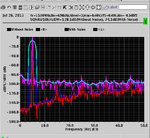Ayman Essam
Member level 2
hi
I would like to measure the ENOB of a sigma-delta ADC on Cadence Virtuoso.
what are the steps to be done ?
do i need MATLAB ?
I would like to measure the ENOB of a sigma-delta ADC on Cadence Virtuoso.
what are the steps to be done ?
do i need MATLAB ?
